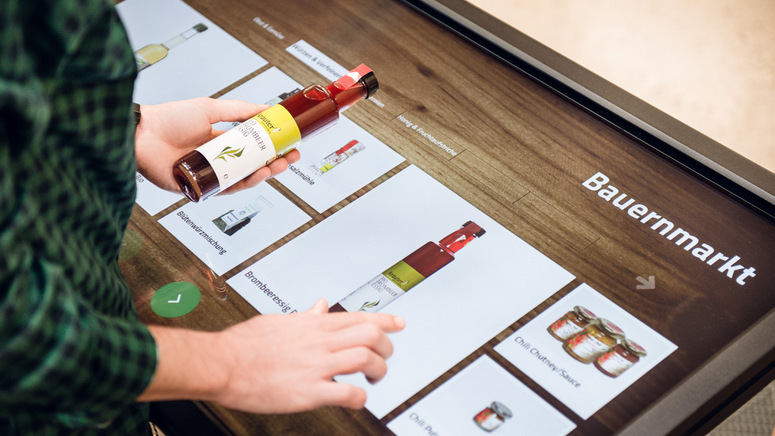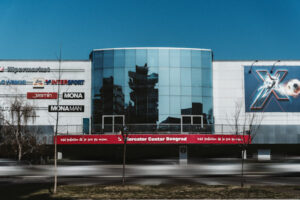ACROSS: Digitization is progressing at a rapid pace. The ways in which to differentiate oneself from the competition are more diverse than ever. What digital solutions represent the current trends?
BERND ALBL: Firstly, let’s take a look at the present. One can see all current possibilities on any shop floor. Electronic Shelf Labeling (ESL), for example, is still a front-runner. Other examples include digital signage, smart tracking, self-checkout, and mobile device integration. Secondly, let’s take a look into the future: There are a number of ideas and concepts, but the products/solutions are not tangible yet. They still have to be fully developed. Primarily, I see a lot in the fields of virtual reality, robotics, artificial intelligence, 5G, and new payment methods. This is accompanied by the ever-increasing awareness of data and privacy security.
ACROSS: What impact do digital measures have on trade?
ALBL: In the future, there will be no pure online or pure in-store trade. Both fields must be harmonized, and retailers must treat their worlds accordingly. At the end of the day, consumers do not differentiate between online and in-store shopping. In the future, it may even be the case that we no longer go shopping, but rather experience and be inspired. Digitization is changing our understanding of shopping. The working environment for future retail employees will also change. The cash register may become obsolete, and robots may be programmed to restock shelves. However, competent advice at the point of sale is becoming increasingly important. This is also something for which employees must develop an understanding.
ACROSS: While many companies assign a decisive role to digitization, others have reservations about digital trends and developments. What are the reasons behind these reservations and how do you overcome them?
ALBL: There is a certain amount of skepticism: on the one hand, because it is an intangible matter, and, on the other hand, because it is a capital-intensive issue. Digitization is not a one-off action – it must be carried out on an ongoing basis. In addition, people also hear about many negative market examples. This notion must be counteracted: Umdasch Digital Retail makes the issue more tangible to people. We comprehensibly explain technologies and emphasize their advantages.
Furthermore, the technology must be a good fit for the retailer’s store concept and, above all, it must be made clear to him how essential it is. He has to feel secure. In conclusion: One must not be guided by trends – one must always keep feasibility/implementability in mind. Just because something looks complex and modern it does not mean that it is appropriate for the retailer. New things, which often lack testimonials, can be scary.

ACROSS: In Austria, consumers are very skeptical about modern mobile payment models, and cash remains king. What are the reasons behind this skepticism, and what opportunities do you see for technologies like NFC, QR codes, apps, etc.?
ALBL: For centuries, we have been used to trading physical goods or paying with cash. This is a habituation pattern, and many of us are security-minded. It’s only a matter of time before that changes. Trust just has to be built. The advantages of digital payment options are obvious.
ACROSS: A look at the world: How far has digitization progressed in German-speaking countries compared to other countries and continents? How do the needs differ?
ALBL: In the German-speaking world, we are even more conservative, but not opposed to the idea of digitization. We are generally open to it, but we approach digitization and the opportunities it offers carefully. Everything is picking up speed and the willingness to invest is increasing. We have also noticed this at Umdasch Digital Retail. However, the consumer is also affected. Asia is the land of Alibaba, and North America is the land of Amazon. These continents are simply faster to adopt the topic of digitization.
ACROSS: Innovations and glimpses into the future are parts of your daily routine. What solutions satisfy tomorrow’s market needs?
ALBL: If the challenge facing you is that by 80% of the population lives in cities and that cultures are growing ever closer together (languages, lifestyles, etc.), then digital possibilities offer great potential to support or realize shopping experiences. Smaller retail areas will be created, high-rise buildings will be built, new transport solutions will be invented, and shops will offer fewer goods.
ACROSS: Multi-channel, cross-channel, and omni-channel are catchwords associated with the digitization of trade. Today’s ever-connected customer is pushing for seamless shopping. What is your understanding of the term, and what might concrete implementation look like?
ALBL: Seamless shopping means that the customer no longer distinguishes between whether his purchases are made online or in-store. For him, shopping no longer entails phases during which he has to choose, pay for, and collect products. That is no longer a concern for the customer. For him, the entire process is simply associated with a comfort factor or a feeling of happiness. Everything else happens in the background. It goes one step further: Retailers even offer the customer the goods he really needs based on his past shopping behavior. The customer does not have to search for the product – the product finds the customer!
Sign up for our ACROSS Newsletter. Subscribe to ACROSS Magazine.





